Table of contents
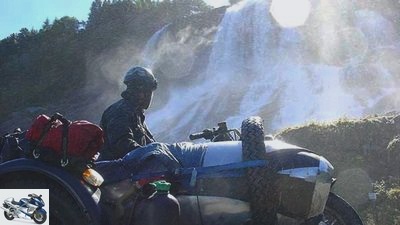
Rotard
to travel
MOTORCYCLE on the go
MOTORCYCLE on the go
Nothing like Fjord: Norway
When old Italian motorcycles encounter Norway’s extreme landscapes and climates, happiness and horror are close together. The story of a trial of strength between technology as strong as nature.
Kerstin Rotard
08/13/2008
Ignition, start button – tick. Then nothing more. No indicator light, no starter, end. Achim is standing next to me, the transfer cable in hand. We look at each other in silence as the drizzle gradually turns into rain. We are dripping with our Guzzis in what is probably the largest Norwegian mud hole in front of us, next to the hut that we had rented for the first night. Everything was already packed – and now this: Achim’s team called “Mrs. Lehmann”, an international promenade mixture of Italian Guzzi Le Mans III, Russian Dnepr boat frame and Hungarian Duna boat, gasped at first tiredly and then no longer at all. And mine “Watz”, A 77 Guzzi T3, should actually donate starting power, but is just shooting through one fuse after the other. Sure, you can push a team, but it doesn’t guarantee a path up that looks like a mud slope from the rain.
Buy complete article
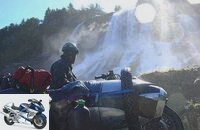
MOTORCYCLE on the go
Nothing like Fjord: Norway
7 pages) as PDF
€ 2.00
Buy now
We were so highly motivated that we steamed to Oslo, almost three weeks and around 1500 kilometers of Norway ahead of us, through the wild south and the fjordland in the west. The weather is cloudy, but with hope. It is now dying twenty kilometers north of Oslo.
I hold the last fuse in my hand and look up the steep driveway when an idea occurs to me: A short circuit on the starter button is likely to kill the fuses. So: dismantle the switch, screw the cable again, put in the fuse, brief prayer, ignition, start button – barommbommbommbommbomm – Watz shakes himself in motion. Achim quickly fetches the neighbour’s car to jump-start, frantically throws the luggage into the boat while I hold Ms. Lehmann on the gas. Minutes later, the Guzzis triumphantly stomp up the driveway, shouting from all pipes, throwing kilos of grass off their rear wheels. The thoughts of the other hut dwellers are almost audible: “They won’t get far with the goats.”
Norway with KTM 990 Adventure
read more
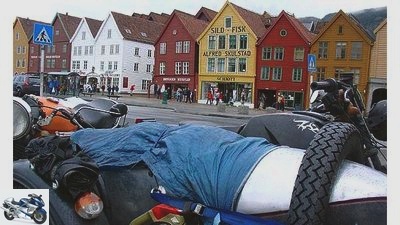
Rotard
Bergen: Norway’s most beautiful city, but 240 rainy days a year seal a fate as a weather hole.
With happily mumbling Guzzen, we go on the hunt for the little blue window in the sky. The streets wind their way gracefully through a gentle, Black Forest-like landscape. I imagined Norway to be different, wilder. It’s like a book that friends keep pushing you. If you then risk a look, ideas are already stuck in your head that it can never live up to. Yes, Norway is beautiful, but overwhelming?
After Mrs. Lehmann has a fresh battery in the belly of the boat, the sun also comes to life. And the book Norway opens the first fascinating chapter: medieval stave churches. At Hegge we see the first: wood on the outside, wood on the inside and hardly a metal nail in the framework. They do not deny their spiritual fathers: inside it looks like looking deep into the keel of a Viking ship.
As we step out of the dark church, which smells of ancient wood and tar, into the open, the clouds rising in the distance reveal the promise of our next destination: the peaks of Jotunheimen. The journey to higher and higher altitudes, however, cools us down to the bone. Raindrops hit the visor, and gray residual snow lines the road. Watz is making increasingly asthmatic noises and I’m worried about the carburettors, which have long been obsolete. The left one can hardly be adjusted. No matter how you turn the screw, the mixture remains the same.
Nevertheless, Watz bravely carries Achim and me to Gjendesee the next day. The people look weird when we stuff everything motorbikes into the big aluminum suitcases and suddenly look like hikers. We cross the lake by boat and trudge back over the Bessegen ridge with the best drizzle and ice-cold whistling wind. High up on this narrow ridge between two mountain lakes, the cloud cover opens for a sublime moment and reveals a broad river delta below us, the arms of which pour like waterfalls into the turquoise glowing Gjende lake. Norway has opened another chapter – that of the great, wild panoramas. The mountains of Jotunheimen, the highest in Scandinavia, breathe greatness and peace. In the evening we decapitate one of our rare red wine bottles.
A remnant remains, which we enjoy 300 kilometers further north, beyond the lush green Romsdalen, which is criss-crossed by waterfalls. The journey dragged on, because whoever is caught with more than 80 km / h on the clock, has to crack the holiday budget! At least Ms. Lehmann gets along wonderfully with the new battery, only Watz still has a slight cough and unstable idling. The next day we plan to take a look at another chapter in the book Norway, which Achim has been raving about for years: the Trollstigen, a top-class pass road.

Rotard
Waterways, the essence of traveling in the north (Lysefjord).
Warm morning sun dissolves the last fine clouds, revealing peaks around 1700 meters high, which still bear traces of snow over green slopes. We enthusiastically tackle the narrow serpentines of the Trollstigen, enjoying the echo of the Guzzen on the gray rock and the warmth on our faces. I go higher and higher with excitement. Behind me I hear Frau Lehmann yelling through the sun-bathed valley as if the rock were about to be blown up. She proudly lifts the boat wheel in the last bend. Finally the right temperature for the open helmet. Smells fill my nostrils, and the spray from the waterfall next to the track sprays onto my cheeks – finally summer.
Greedily I turn to the next page in the book Norway: Fjords. You will become my great love and will ultimately convince me of the entire book. Blue tongues between sometimes steep, sometimes wide rock faces, always carrying the salty sea smell and on their sides little streets to dream about. Around every corner new perspectives, new mountains, new shades of blue.
On the way to the Geirangerfjord, Watz is once again moody: the charge control lights up and signals emergency power operation. In the port of Eidsdal I unscrew the Lima cover and borrow a screw from a BMW driver to push the rotor. We forgot that, but we have a spare rotor and stator with us. For the time being, Watz is content with adjusting carbon tension springs in order to produce juice again.
Then it goes down in magnificent serpentines to the deep blue Geirangerfjord and then by ferry along the vertical rock faces and waterfalls of what is perhaps the most beautiful fjord in Norway. In the harbor of Hellesylt there is no longer a blue sky to be seen. We are looking for a small road further south through the high-lying Vindedalen. Fine gravel, together with the onset of rain, make the journey a torture. Despite July, it is freezing cold and the road is flanked by snow. Fun is different. A quick look at the stave church in Lom, then part two of the alpine part comes: Reichsstrabe 55 leads us over a 1434 meter high pass. That doesn’t sound impressive, but due to Norway’s polar orientation, this corresponds to an alpine pass around 2500 meters high. Both in terms of the vegetation and the weather. Sleet again lashes into the open helmets, again only a few meters of view. We carefully navigate through the serpentines to the plateau, the fell.
It is a bit of luck when the sleet on your face slowly gives way to a lukewarm shower on the descent. Relieved, we meander through the valley towards the Lustrafjord. At the first point that allows you to make coffee without frostbite, we unpack the pots and warm ourselves in the steaming mugs. After that, Watz says nothing more. It catches itself when rolling, but when I switch off the charge indicator light by hand, I suspect a tell-tale glow. Lima and battery do not speak to each other again.
Watz dragged himself until shortly before Gaupne, then the battery was empty. Achim clears Ms. Lehmann’s battery and transfers it. The cause is soon found at the campsite: The fine mountain mud has worked its way through the Lima ventilation and clogged everything. Now comes the time for the spare parts that you brought with you, because now the coals have also been rubbed off to such an extent that we are installing the replacement stator.
While Watz’s battery is sucking up strength again on the campsite attendant’s charger, Ms. Lehmann, Achim and I go on a trip across the country. We visit the huge ice tongue of the Nigardsbreen, a branch of the Jostedalsbreen, the largest glacier on the European mainland. Then we rush around the Lustrafjord to visit the oldest stave church in Norway in Urnes, right across from the campsite.
The fjord chapter does not close so quickly. Without a lot of screwing – just adjust the carburetor once or twice and replace a lost engine and crash bar bracket at Watz – we travel on, accompany the Sognefjord, which has dug itself a sensational 204 kilometers into the country, cross its southern neighbors by ferry, enjoy one carefree day in the cozy, but rainy port city of Bergen and finally flow into the Lysefjord. This is where Achim starts the biggest Lehmann screwing on the tour: the rear tire is due. But Achim took precautions and, to the amusement of many locals and tourists, carried a spare tire over the boat’s nose. While I am uncorking the last bottle of red wine, Achim takes off the bike. Lo and behold, a permanent camper even comes with a mini compressor for the subsequent air filling.
Ms. Lehmann tests her new profile the very next day on the trip to the Prekestolen. At the parking lot, however, is over for them, because on the huge rock, which is not in vain “Sermon chair” means you can only hike. It protrudes far out over the Lysefjord like a pulpit, and slightly dizzy we stare down the 600-meter vertical wall to the water. With this look we wistfully close the chapter on the fjords.
We roll across the country back to the ferry port in Oslo, still brushing a few fells. Some are bursting with green, others resemble a lunar landscape, others shimmer colorfully from the countless lichens that grow on the stones. Wild and bizarre they write the last chapter of the book that has become so captivating for the time being. Which I sincerely hope that someone will have a sequel ready for me.
Information about Norway
Norway is considered by many to be the most beautiful country in Europe. No other offers such dramatic mountain and coastal landscapes at the same time. The only downside: it’s also the most expensive. But if you can handle a tent, stove and sometimes harsh weather, you will find a dream destination.
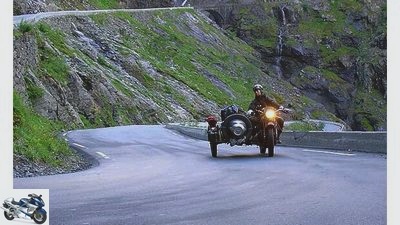
Rotard
Magnificent stacks of serpentines on the Trollstigen.
General
Norway is roughly the size of Germany, but only about a fifth of the population. The result: enchanting landscapes that are almost deserted, especially in the north, and seldom overcrowded even in the livelier south. The rugged west coast with its innumerable fjords, some of which stretch hundreds of kilometers inland, is characteristic. The Sognefjord (around 300 kilometers northwest of Oslo) is the longest at 204 kilometers, while the Geirangerfjord with its imposing waterfalls and steep cliffs is probably the most dramatic. There are also plenty of alpine mountain roads to enjoy all around, especially in the Jotunheimen mountain range. There, the highest mountains in Scandinavia are pounding around the 2,469 meter high Galdhoppigen.
getting there
Several ferry routes bring travelers across the North Sea to Norway. The night trip Kiel – Oslo with Colorline (www.colorline.de), including a cruise atmosphere, is particularly beautiful. Two people pay around 310 euros in the inexpensive cabin class (booking only possible with a cabin) plus two motorcycles in the high season. Carriages cost 36 euros more, which is the same as cars (80 instead of 46 euros). In Denmark there are other departure options to different ports. More details in the ferry overview in MOTORRAD 15/2007. Or at www.ocean24.de.
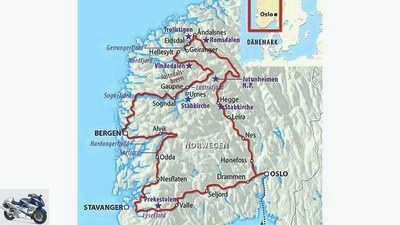
Map: Maucher
Duration of the trip: 3 weeks; Distance: 1500 kilometers
Stay
Tents or huts are most recommended in Norway, as hotels and restaurants are almost unaffordable. Campers also have the right to spend a night on non-private property. On the other hand, the campsites are often nicely located and not expensive. For two people plus motorcycles, the cost is often little more than twelve euros. The price even includes washer and dryer. Camping huts are indispensable in bad weather (“Hytter”), which can be found on campsites or in specially marked areas.
activities
The ancient stave churches with origins in the Viking Age are particularly impressive. The oldest is in Urnes on a branch of the Sognefjord. Hiking is also an option in Norway. Particularly beautiful: the Bessegen ridge in Jotunheimen, a hearty day tour on a narrow ridge between two mountain lakes. Or the Prekestolen over the Lysefjord with its imposing perspective from a 600 meter high, vertical rock face down. The Jostedalsbreen is also sensational – with 490 square kilometers the largest glacier on the European mainland. Its foothills are easy to explore on foot from the parking lots along Reichsstrabe 604 at Gaupne. If you are more into cities, you shouldn’t miss Bergen and its old wooden houses in the harbor. In Oslo, you can visit a campsite high above the city. Tip: Spend two nights there and see the sculptures in Vigelandpark, among other things.
literature
Baedeker “Norway” (with a map at a scale of 1: 800,000, which is completely sufficient for the distance traveled), 22.95 euros. Also good, but actually unnecessary for this tour: Superatlas Scandinavia, Freytag Berndt, 1: 250,000 to 1: 400,000, 29.95 euros. Sheets can be removed, trimmed and individually laminated.
Related articles
-
MOTORCYCLE on the road in Morocco
Brings to travel MOTORCYCLE on the road in Morocco MOTORCYCLE on the road in Morocco North Africa’s last gap It has become tight in the northern Sahara….
-
Motorcycle trip – Norway in summer
Joachim Deleker to travel Motorcycle trip – Norway in summer Motorcycle trip – Norway in summer Weatherproof Norway in summer, time of light, time for a…
-
Morocco motorcycle tour for Africa beginners
Iron ham to travel Morocco motorcycle tour for Africa beginners Morocco motorcycle tour for Africa beginners Allah’s wild rock garden Mysterious cities,…
-
Motorcycle tour through Algeria
to travel Motorcycle tour through Algeria Motorcycle tour through Algeria The dunes of the Sahara Algeria. The grave road, the sand dunes from Erg…
-
Motorcycle tour in southern Norway
Dirk Schafer 18th pictures Dirk Schafer 1/18 There quickly: via Hirtshals / Denmark to the Norwegian ferry port Kristiansand. Dirk Schafer 2/18 Excellent…
-
Breakable 22nd pictures Breakable 1/22 Island happiness: The slender streets of the Isle of Mull enchant especially around the highest mountain Ben More…
-
Motorcycle trip to the Sibillini Mountains in Italy
Daams 23 pictures Daams 1/23 Grasses in the evening breeze: like the hair of young fairies (or Silvio’s playmates …) Daams 2/23 Pilgrimage site: Sunday…
-
In the Bavarian Forest by motorcycle
Seitz to travel In the Bavarian Forest by motorcycle Motorcycling in the Bavarian Forest Especially good in winter Riding a motorcycle in the dark…
-
At the end of the motorcycle season, heavenly peace returns on the mountain pass roads.
Iron ham to travel At the end of the motorcycle season, heavenly peace returns on the mountain pass roads. In autumn by motorcycle in the Dolomites…
-
Motorcycle tour – border between Sweden and Norway
Deleker 22nd pictures Jo Deleker 1/22 On all fells – on the move in Sweden. Jo Deleker 2/22 Swedish moments: curious moose. Jo Deleker 3/22 Swedish…